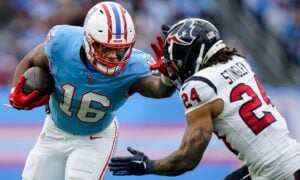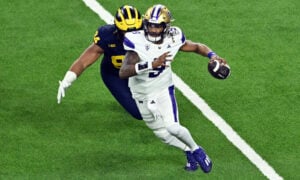Bringing the Quarter-Back to Life

Imagine this scenario for a moment. You’re cruising along at 4-0 going into this week, led by week-after-week of top production from Julio Jones (and there are surely quite a few enjoying his production this year.) But then King Chaos of the NFL strikes and Julio breaks his leg. It’s a blow, for sure, but you hit the waiver wire to bolster your roster. You look over your options and pick up Demariyus Thomas for the following week.
Whoa whoa whoa, you say. (I can see the look on your face through the internet.) There’s no way DT is available on any waiver wire out there, unless there’s some league populated by seven year olds picking their players based on how easily they can spell their names. Let’s try this again.
Same scenario, only this time you lose a running back. Adrian Peterson pulls a hamstring and you find yourself short a starting running back. So you go and pick up Giovani Bernard to fix your roster problem.
Oh, that doesn’t work either, huh? Bummer.
Let’s look at one last example. Drew Brees aggravates that pesky shoulder, and they officially shut him down for 6-8 weeks. This time you hit the waivers and pick up Ryan Fitzpatrick and just for safety’s sake you pick up Alex Smith as well.
Why is it that this third scenario is possible and the first two are beyond the pale? How is the most important position in football currently only marginally more important than the kicker in fantasy? Here are some reasons fantasy must evolve and make 2QB and superflex leagues part of the new standard. I believe it’s time we bring the quarter-back to life.
Quarterback Scoring Differential
To set the stage, let’s take a look at the top 12 quarterbacks from 2014 (statistics courtesy of ProFootballFocus.com🙂

First, look at Andrew Luck versus Philip Rivers (we’ll compare those two since Tony Romo played one less game) – Luck scored nearly six more points per game than Rivers. It’s a reasonable number, but also not a truly dominant difference. By way of comparison, the difference between the top running back (Le’Veon Bell) and the RB12 (LeSean McCoy) was over ten points per game.
But that’s only part of the story. Notice how little space there is between Russell Wilson and Rivers. There’s fewer than three points per game separating the two players – and that means everyone between is just as close in terms of production.
In startup dynasty drafts, Wilson is going around the fourth round, while Rivers can be had in the eleventh round – sometimes later than that. The miniscule scoring gap (which has grown ever more obvious to savvy dynasty owners) has led directly to the prevalence of the late quarterback draft strategy. Why spend an early startup pick when you can get comparable value much later in the draft?
Now imagine you have two starting spots for quarterback. The difference between Luck and Blake Bortles, the 24th ranked quarterback last year, was a full ten points. Now that’s a different story.
Quarterback Trading
Think about this for a moment. How often do you see a deal in any of your leagues where a quarterback is the centerpiece? Again, we’re talking about the most important position in football and there are far fewer deals with the quarterback as the centerpiece than running backs, wide receivers or tight ends. Spend a little time reading the “Completed Dynasty Trades Only” thread on the DLF forums to see the real-world implications.
The deals involving the quarterback position are most often due to injury, desperation or both. Many deals went down recently involving Tony Romo owners, for instance, but chances are they were rather insignificant. Second round picks being sent for someone’s backup quarterback, for instance. You’ll also see late season deals where contenders give up relative peanuts for depth or even starters at quarterback.
The only substantial deals seen around the position usually involve the top two players at the position, Andrew Luck or Aaron Rodgers. And even those deals are rarely real blockbusters. Luck for a slightly lesser quarterback and another piece, or perhaps for a collection of picks.
The point here is depth at the quarterback position rarely translates into any real profit. Most owners see themselves better off stocking running back or wide receiver assets and are content to roster one or two decent quarterback options and largely ignore the position. Ignore quarterback in 2QB or superflex leagues at your own peril. Unless of course you’re after the first overall pick.
Lineup Decisions
Even the art of setting a good lineup is dead as a doornail when it comes to quarterback. Since most teams keep a single quarterback and roll with him week after week, few of us spend much time studying matchups or analyzing performance. Most startable quarterbacks manage to produce at a fairly steady clip, so the nuances of matchups are lost on them.
There are exceptions to this, as the late quarterback strategy prevalent in dynasty and other leagues does lead to more engaged lineup management. The quarterback streaming strategy has this effect as well, but this is not ideal (or even possible in many cases) in the dynasty setting.
In any case, we spend less time worrying about who to start at quarterback than any other offensive skill position. And there are certainly at least some owners out there who spend more time thinking about kicker than quarterback. This attitude is impossible in 2 QB and superflex leagues. Superflex even gives an added layer of complexity over 2QB leagues – do you always start a quarterback in that spot or can it be beneficial to start a fourth wide receiver instead?
Quarterbacks and Tight Ends
Many give these two positions relatively equal value. And they do share many similarities. Neither position is valued as high as running back or wide receiver. Both positions also share the same sort of top heaviness. For tight end, the standard line is “to Gronk or not to Gronk.” You either draft or target Rob Gronkowski, or you plumb the depths for someone else. Even Jimmy Graham has fallen off the radar recently with his move to Seattle. This is similar to quarterback, where only Luck and Rodgers are worthy of early picks or hefty trade offers. Everyone else is fodder.
But the way these two positions score is quite different. Even quarterbacks on bad NFL teams contribute quite a few fantasy points. Poorly performing tight ends often deliver goose eggs in the fantasy box score, but this is rarely the case with quarterbacks. Even the worst Sunday stat line includes passing touchdowns or enough passing yards to score some fantasy points. Because of the veritable impossibility of accurately predicting the tight end position, it makes more sense for it to be marginalized a bit in fantasy. This is not the case with quarterback. Heck, it would be cruel and unusual to require two tight ends in the lineup, seeing that many zeroes might make you physically ill.
There can be no doubt; the quarterback is half-buried in most fantasy leagues. The startup average draft position for quarterbacks is in the garbage, their trade value is in the toilet and any true strategy around quarterback is long since dead. They currently share the “anti-limelight” with tight ends in the marginalized fringes of fantasy. They aren’t quite in the ghostlands of kickers and defenses, but they aren’t far from it.
But 2QB and superflex leagues can cure all of these ills and resurrect the quarterback position. Both have been around for a while now and they could and should become the standard league choice in the near future. Remember, PPR leagues were once a mere offshoot or alternative, but over time fantasy players realized the benefits of the added flexibility PPR leagues provided, and now they are the norm. 2QB and superflex leagues have a similar quality as they open up new levels of strategy to fantasy players. Even in an established league, you can slowly transition to the new format without a lot of difficulty. As long as all owners understand the timing, it can be done. But the time has come for the fantasy community to embrace these new, more flexible formats. Continuing to ignore the quarterback position is a detriment to the game as it is the most important position in the NFL and it’s also the most visible to new players. Let’s shock some life back into the quarterback position and give it the importance it deserves.
[ad5]
- Sunday Six Pack: Week Seven - October 25, 2020
- DLF’s Dynasty Predictions: Fantasy MVP - September 8, 2020
- DLF’s Dynasty Predictions: Fantasy Rookie of the Year - September 7, 2020


































































